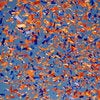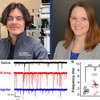
Contact Information
Research Interests
Research Topics
Endocrinology, Ion Channels, Neurobiology, Synaptic Transmission
Disease Research Interests
Neurological and Behavioral Disorders, Reproductive Diseases, Infertility, and Menopause
Research Description
Cellular, synaptic, and circuit neurophysiology in neuroendocrinology and epilepsy
Our laboratory explores research questions at the intersection of neuroscience, physiology, and endocrinology, with an emphasis on interactions between the brain and endocrine systems in the context of seizures and epilepsy.
We are particularly interested in the neural and pituitary mechanisms of epilepsy-associated reproductive endocrine disorders. Both women and men with temporal lobe epilepsy, the most common form of epilepsy seen in adults, show higher rates of reproductive endocrine disorders in comparison with the general population. Importantly, reproductive endocrine problems can reciprocally impact the severity of epilepsy seen and influence the choice and efficacy of anti-seizure treatments. We aim to understand the mechanisms by which temporal lobe seizures impact the hypothalamic-pituitary control of reproduction.
A parallel area of research in the lab examines sex differences and hormone actions in epilepsy and seizure susceptibility. We have found fluctuations in seizure activity with estrous cycle stage in female mice with epilepsy, differences in seizure activity between male and female mice, and sex differences in changes in acute seizure susceptibility that are revealed after gonadectomy to remove gonadal hormones. Our ongoing work is aimed at understanding the distinct roles of gonadal hormones and sex chromosomes in shaping sex differences in seizures and epilepsy, and the influences of sex and hormone signaling on neural excitability and seizure susceptibility in Alzheimer's disease.
We are also currently working to develop new mouse models of hypothalamic hamartomas, which are rare pediatric brain tumors that cause severe epilepsy, central precocious puberty, and cognitive and behavioral changes.
To perform our research, we use several techniques including patch clamp electrophysiology, optogenetics/chemogenetics, stereotactic surgeries, electroencephalography (EEG), viral vectors, neuroanatomy, and behavioral assays.
Education
A.B. 2001 Smith College, Northampton, MA
Ph.D. 2008 University of Virginia, Charlottesville, VA
Postdoc 2008-2014 Stanford University School of Medicine, Stanford, CA
Awards and Honors
James and Maxine Heath Award for Excellence in Teaching Physiology, 2025
Neuroscience Program Faculty Mentor Recognition Award, UIUC, 2024
University of Virginia Medical Alumni Association Distinguished Achievement in Biomedical Sciences Award, 2023
Center for Advanced Study Fellow, UIUC, 2020-2021
NARSAD Young Investigator, 2016-2018
Citizens United for Research in Epilepsy (CURE) Taking Flight Award, 2014
McCormick Advanced Postdoctoral Fellowship, Stanford School of Medicine, 2012
Epilepsy Foundation Postdoctoral Fellowship, 2011
Endocrine Scholars Award, The Endocrine Society, 2008
Peach Outstanding Graduate Student Award, University of Virginia, 2006
NIH National Research Service Award, 2005-2007
Fulbright Fellowship to Italy, 2001
Beckman Foundation Science Scholarship, 2000
Courses Taught
Additional Campus Affiliations
External Links
Highlighted Publications
Representative Publications
French AR, Christian-Hinman CA (2025) Aromatase inhibition modulates intrinsic properties and excitability of hippocampal CA1 pyramidal cells in the APP/PS1 mouse model of Alzheimer's disease. Experimental Neurology 392:115365
Rajan R, Christian-Hinman CA (2024) Sex-dependent changes in gonadotropin-releasing hormone neuron voltage-gated potassium currents in a mouse model of temporal lobe epilepsy. eNeuro 11:ENEURO.0324-24.2024
Christian-Hinman CA (2024) The promise and practicality of addressing sex as a biological variable and the ovarian cycle in preclinical epilepsy research. Epilepsy Currents 24:274-279
Courtney CD, Sobieski C, Ramakrishnan C, Ingram RJ, Wojnowski NM, DeFazio RA, Deisseroth K, Christian-Hinman CA (2023) Optoalpha1AR activation in astrocytes modulates basal hippocampal synaptic excitation and inhibition in a stimulation-specific manner. Hippocampus 33:1277-1291
Lawande NV, Conklin EA, Christian-Hinman CA (2023) Sex and gonadectomy modify behavioral seizure susceptibility and mortality in a repeated low-dose kainic acid systemic injection paradigm in mice. Epilepsia Open 8:1512-1522
Cutia CA, Christian-Hinman CA (2023) Mechanisms linking neurological disorders with reproductive endocrine dysfunction: Insights from epilepsy research. Frontiers in Neuroendocrinology 71:101084
Cutia CA, Leverton LK, Christian-Hinman CA (2023) Sex and estrous cycle stage shape left-right asymmetry in chronic hippocampal seizures in mice. eNeuro 10:ENEURO.0041-23.2023
Cutia CA, Leverton LK, Weis KE, Raetzman LT, Christian-Hinman CA (2023) Female-specific pituitary gonadotrope dysregulation in mice with chronic focal epilepsy. Experimental Neurology 364:114389
Ingram RJ, Leverton LK, Daniels VC, Li J, Christian-Hinman CA (2022) Increased GABA transmission to GnRH neurons after intrahippocampal kainic acid injection in mice is sex-specific and associated with estrous cycle disruption. Neurobiology of Disease 172:105822
Li J, Christian-Hinman CA (2022) Epilepsy-associated increase in gonadotropin-releasing hormone neuron firing in diestrous female mice is independent of chronic seizure burden severity. Epilepsy Research 184:106948
Cutia CA, Leverton LK, Ge X, Youssef R, Raetzman LT, Christian-Hinman CA (2022) Phenotypic differences based on lateralization of intrahippocampal kainic acid injection in female mice. Experimental Neurology 355:114118
Li J, Leverton LK, Naganatanahalli LM, Christian-Hinman CA (2020) Seizure burden fluctuates with the female reproductive cycle in a mouse model of chronic temporal lobe epilepsy. Experimental Neurology 334:113492
Christian CA, Reddy DS, Maguire J, Forcelli PA (2020) Sex differences in the epilepsies and associated comorbidities: Implications for use and development of pharmacotherapies. Pharmacological Reviews 72:767-800
Lawande NV, Ujjainwala AL, Christian CA (2020) A single test to study social behavior and repetitive self-grooming in mice. Bio Protocol 10:e3499
Pantier LK, Li J, Christian CA (2019) Estrous cycle monitoring in mice with rapid data visualization and analysis. Bio Protocol 9:e3354
Ujjainwala AL, Courtney CD, Wojnowski NM, Rhodes JS, Christian CA (2019) Differential impacts on multiple forms of spatial and contextual memory in diazepam binding inhibitor knockout mice. Journal of Neuroscience Research 97:683-697
Li J, Robare JA, Gao L, Ghane MA, Flaws JA, Nelson ME, Christian CA (2018) Dynamic and sex-specific changes in gonadotropin-releasing hormone neuron activity and excitability in a mouse model of temporal lobe epilepsy. eNeuro 5:ENEURO.0273-18.2018
Courtney CD, Christian CA (2018) Subregion-specific impacts of genetic loss of diazepam binding inhibitor on synaptic inhibition in the murine hippocampus. Neuroscience 388:128-138
Ujjainwala AL, Courtney CD, Rhoads SG, Rhodes JS, Christian CA (2018) Genetic loss of diazepam binding inhibitor in mice impairs social interest. Genes, Brain and Behavior 17:e12442
Li J, Kim JS, Abejuela VA, Lamano JB, Klein NJ, Christian CA (2017) Disrupted female estrous cyclicity in the intrahippocampal kainic acid mouse model of temporal lobe epilepsy. Epilepsia Open 2:39-47
Christian CA (2017) Neurophysiology of gonadotropin-releasing hormone neurons. Hormones, Brain and Behavior, 3rd ed. Vol. 3, 379-400
Recent Publications
French, A. R., & Christian-Hinman, C. A. (2025). Aromatase inhibition modulates intrinsic properties and excitability of hippocampal CA1 pyramidal cells in the APP/PS1 mouse model of Alzheimer's disease. Experimental Neurology, 392, Article 115365. https://doi.org/10.1016/j.expneurol.2025.115365
Scott, R. C., Hsieh, J., McTague, A., Mahoney, J. M., & Christian-Hinman, C. A. (2025). Merritt-Putnam Symposium | Developmental and Epileptic Encephalopathies—Current Concepts and Novel Approaches. Epilepsy Currents, 25(3), 229-235. Advance online publication. https://doi.org/10.1177/15357597251320142
Christian-Hinman, C. A. (2024). The Promise and Practicality of Addressing Sex as a Biological Variable and the Ovarian Cycle in Preclinical Epilepsy Research. Epilepsy Currents, 24(4), 274-279. https://doi.org/10.1177/15357597241261463
Kumar, V., Lee, K. Y., Acharya, A., Babik, M. S., Christian-Hinman, C. A., Rhodes, J. S., & Tsai, N. P. (2024). mGluR7 allosteric modulator AMN082 corrects protein synthesis and pathological phenotypes in FXS. EMBO Molecular Medicine, 16(3), 506-522. https://doi.org/10.1038/s44321-024-00038-w
Nagarajan, R., Lyu, J., Kambali, M., Wang, M., Courtney, C. D., Christian-Hinman, C. A., & Rudolph, U. (2024). Genetic Ablation of Dentate Hilar Somatostatin-Positive GABAergic Interneurons is Sufficient to Induce Cognitive Impairment. Molecular Neurobiology, 61(2), 567-580. https://doi.org/10.1007/s12035-023-03586-3




